Halifax
Halifax Harbour
04/07/12 13:30 Filed in: Travel
Today was our day to visit Halifax since we will hit the road early to see a Ceilidh in Judique on Cape Breton Island. We love celtic music and this area is certainly a center of it. Many good artists come from this region.
But I jump ahead. This morning we toured The Citadel. This is the main fortress on top of a hill overlooking Halifax harbour. It is now a tourist site yet was an active fortification for 200 years. There were many young men in dress uniform performing tasks. In questioning, we find that they are students primarily working and performing a role and not active military. They seem to do a good job and certainly appear authentic. The following is a picture of the Clock Tower at the base of the Citadel with the Convention Center just behind along with Halifax Harbour even farther in the distance. The Clock Tower is very distinctive landmark in the city.
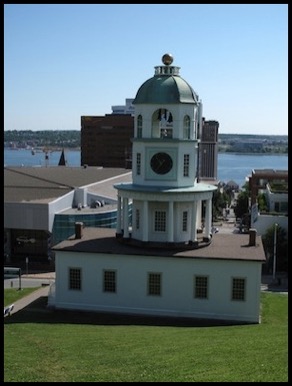
The Citadel was established in 1746 and the Noon Gun has been fired every day since 1856, maybe even since the 1700’s. We were fortunate to watch the military ceremony to load and fire the Noon Gun. You can see from this picture below how they were set up to fire.
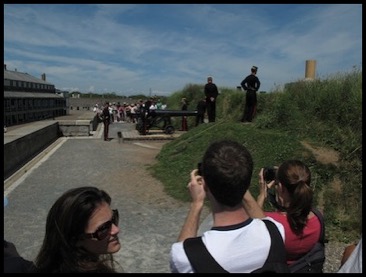
The Pipes and Drum corps were on hand at shortly after noon to play a rousing group of songs. I can see why at one time they banned the bagpipes as a war weapon since it can be rousing to follow the call of the pipes and drums. A great way to get in the mood for our celtic journey.
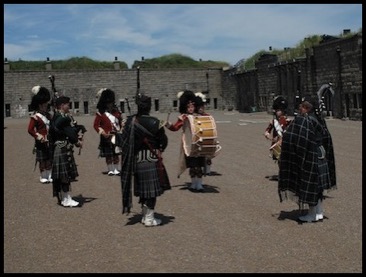
The rest of the afternoon was spent touring the Maritime Museum of the Atlantic. It had a lot of interesting exhibits under its roof. Two that caught my interest were one-- the display on the ships and people who laid communication cable from Nova Scotia or Newfoundland across the Atlantic to Britain or France over the last 100 years plus. Dangerous work with a need for many skills. One cable ship responded to the Titanic disaster since they were better able to retrieve the bodies that were found from the ocean surface. The other exhibit covered the terrible disaster that hit Halifax on the morning of December 6, 1917. A French munitions ship, the Mont Blanc, was entering the harbor and was hit by a Norwegian vessel, the Imo. A fire started and burned on the Mont Blanc. The French sailors knew the danger and left the ship to take shelter in nearby woods. Many of the people in Richmond (this section of Halifax) were unsuspecting or went to sightsee. A massive explosion leveled the area killing thousands and injuring possibly 25,000. A personal note in a film shown at the museum said one family lost 25 members. So very sad.
But I jump ahead. This morning we toured The Citadel. This is the main fortress on top of a hill overlooking Halifax harbour. It is now a tourist site yet was an active fortification for 200 years. There were many young men in dress uniform performing tasks. In questioning, we find that they are students primarily working and performing a role and not active military. They seem to do a good job and certainly appear authentic. The following is a picture of the Clock Tower at the base of the Citadel with the Convention Center just behind along with Halifax Harbour even farther in the distance. The Clock Tower is very distinctive landmark in the city.

The Citadel was established in 1746 and the Noon Gun has been fired every day since 1856, maybe even since the 1700’s. We were fortunate to watch the military ceremony to load and fire the Noon Gun. You can see from this picture below how they were set up to fire.

The Pipes and Drum corps were on hand at shortly after noon to play a rousing group of songs. I can see why at one time they banned the bagpipes as a war weapon since it can be rousing to follow the call of the pipes and drums. A great way to get in the mood for our celtic journey.

The rest of the afternoon was spent touring the Maritime Museum of the Atlantic. It had a lot of interesting exhibits under its roof. Two that caught my interest were one-- the display on the ships and people who laid communication cable from Nova Scotia or Newfoundland across the Atlantic to Britain or France over the last 100 years plus. Dangerous work with a need for many skills. One cable ship responded to the Titanic disaster since they were better able to retrieve the bodies that were found from the ocean surface. The other exhibit covered the terrible disaster that hit Halifax on the morning of December 6, 1917. A French munitions ship, the Mont Blanc, was entering the harbor and was hit by a Norwegian vessel, the Imo. A fire started and burned on the Mont Blanc. The French sailors knew the danger and left the ship to take shelter in nearby woods. Many of the people in Richmond (this section of Halifax) were unsuspecting or went to sightsee. A massive explosion leveled the area killing thousands and injuring possibly 25,000. A personal note in a film shown at the museum said one family lost 25 members. So very sad.
Comments
The Evangeline Trail
It was with sadness that we left our hosts in Annapolis Royal. Bill and Ann Marie were about the best B and B hosts you could find. We shared a number of stories and laughs while there. We met a lovely couple, Bob and Susan, from Halifax during the first two days. They were so kind to share some of their lobster purchased over on the Bay of Fundy. Fortunately, Susan was an expert at cracking lobsters since we are ham-handed. It was so good! Now, when it comes to pig, Susan is less apt. They went to the local Pig Feed just down the road at the community center on the night of Canada Day. We wanted to go and could not get tickets for the same time. When it came time that the roasted pigs were carried out “in whole” and served right off the pig, Susan said she could not look at the pig or eat it. The production and look were too much for her.
Well, on to packing up and going down the Annapolis River Valley to follow the Evangeline trail. The farm land was impressive, especially around Kentville and the Acadian dyke land of Grand Pre. Grand Pre is the center of “Le Grand Derangement”. On july 28, 1755, the Acadians (the men) were invited to meet with the area’s Governor. While there, they were surrounded by troops and promptly separated from their families to be transported to ships and dispersed to other areas. This is the start of the Acadians being sent to New Orleans, Quebec, New England, and France. Despite the dispersement, the Acadians have survived and carried on their traditions. They could not have had a better spokesperson as Henry Wadsworth Longfellow in his poem, Evangeline.
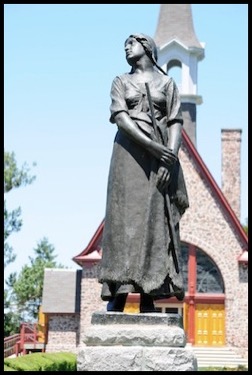
Evangeline statue at the National Park
The National Park service has a lovely museum and headquarters in Grand Pre. The Park covers about 14 acres with lovely gardens and it also looks over the dykelands the Acadians developed. There is a memorial church on the grounds and it gives more history and color to the trials of the Acadians. Just this last Saturday, the Park Service found that this site had been designated a UNESCO World Heritage Site, one of 16 in Canada (three in Nova Scotia).
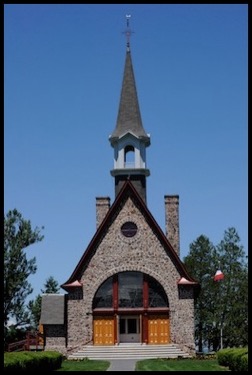
While at the church, I noticed two children enjoying the church cat. The young man said he loved cats............my kind of people. So Bob got a photo of us with Evangeline, the 16 year old church cat.
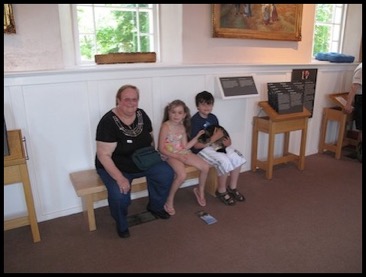
We got to Halifax about 4 p.m. and prepared to attend the Royal Nova Scotia International Tattoo at the Convention Center in Halifax. The Tattoo was spectacular and full of talented people. The U.S. was represented by the Band of America’s Few. It is made up of retired Marine band members. The focus this year was on the Queen’s 60th Jubilee year, the 100th anniversary of the sinking of the Titanic, and the 200th anniversary of the War of 1812. Highlights were the 1812 Overture at the end of the first act and the high wire scaffold act above the center arena floor of the Paris Police Officers Group who perform impressive gymnastics. The pipes and drums at the Tattoo.
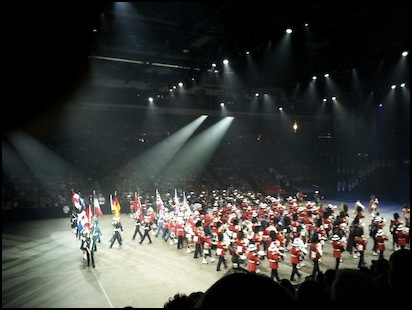
Royal Nova Scotia International Tattoo
Well, on to packing up and going down the Annapolis River Valley to follow the Evangeline trail. The farm land was impressive, especially around Kentville and the Acadian dyke land of Grand Pre. Grand Pre is the center of “Le Grand Derangement”. On july 28, 1755, the Acadians (the men) were invited to meet with the area’s Governor. While there, they were surrounded by troops and promptly separated from their families to be transported to ships and dispersed to other areas. This is the start of the Acadians being sent to New Orleans, Quebec, New England, and France. Despite the dispersement, the Acadians have survived and carried on their traditions. They could not have had a better spokesperson as Henry Wadsworth Longfellow in his poem, Evangeline.

Evangeline statue at the National Park
The National Park service has a lovely museum and headquarters in Grand Pre. The Park covers about 14 acres with lovely gardens and it also looks over the dykelands the Acadians developed. There is a memorial church on the grounds and it gives more history and color to the trials of the Acadians. Just this last Saturday, the Park Service found that this site had been designated a UNESCO World Heritage Site, one of 16 in Canada (three in Nova Scotia).

While at the church, I noticed two children enjoying the church cat. The young man said he loved cats............my kind of people. So Bob got a photo of us with Evangeline, the 16 year old church cat.

We got to Halifax about 4 p.m. and prepared to attend the Royal Nova Scotia International Tattoo at the Convention Center in Halifax. The Tattoo was spectacular and full of talented people. The U.S. was represented by the Band of America’s Few. It is made up of retired Marine band members. The focus this year was on the Queen’s 60th Jubilee year, the 100th anniversary of the sinking of the Titanic, and the 200th anniversary of the War of 1812. Highlights were the 1812 Overture at the end of the first act and the high wire scaffold act above the center arena floor of the Paris Police Officers Group who perform impressive gymnastics. The pipes and drums at the Tattoo.

Royal Nova Scotia International Tattoo

